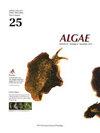Cryptic diversity and phylogeographic patterns of Plocamium telfairiae and P. cartilagineum (Plocamiales, Rhodophyta) in the Northwest Pacific
IF 2.4
3区 生物学
Q1 MARINE & FRESHWATER BIOLOGY
引用次数: 1
Abstract
Cryptic diversity refers to two or more distinct species classified as a single species due to lack of morphological difference. Although Plocamium Lamouroux has potential applications in biotechnology, several phylogenetic studies suggest the presence of cryptic diversity within the genus that requires further phylogenetic evaluation. Here, we investigated two species of Plocamium, P. “cartilagineum” and P. “telfairiae”, in the Northwest (NW) Pacific. The aims of this study are to identify potential cryptic species by analyzing the genetic differences between the species from their type localities and specimens from the NW Pacific, to characterize their population genetic diversity and structure, and to find potential hotspots with high intraspecific genetic diversity in Korea. A reconstructed phylogenetic tree based on mitochondrial 5′ region of cytochrome c oxidase subunit I (COI-5P) and plastid ribulose-1,5-bisphosphate carboxylase / oxygenase large subunit (rbcL) with molecular delimitation methods revealed significant differences as distinct species in the genus Plocamium. Comparison with specimens from their type localities indicated the presence of two cryptic species in the NW Pacific, including Plocamium luculentum sp. nov. The phylogeographic study for both species showed low genetic differences among populations, demonstrating genetic connectivity within the NW Pacific. These findings could promote the discovery of other morphologically and ecologically similar but phylogenetically different Plocamium species worldwide, which is essential for conservation assessments.西北太平洋地区飞龙和软骨鱼(飞龙目,红水螅目)的隐生多样性和系统地理格局
隐多样性是指两个或多个不同的物种由于缺乏形态差异而被分类为一个物种。虽然Plocamium Lamouroux在生物技术方面有潜在的应用,但一些系统发育研究表明,该属中存在隐多样性,需要进一步的系统发育评估。本文对西北(NW)太平洋两种Plocamium, P.“软骨”和P.“telfairiae”进行了研究。本研究的目的是通过分析不同类型地区和西北太平洋标本之间的遗传差异,鉴定潜在的隐种,并对其种群遗传多样性和结构进行表征,寻找韩国种内遗传多样性高的潜在热点地区。基于线粒体5′区细胞色素c氧化酶亚基I (COI-5P)和质体核酮糖-1,5-二磷酸羧化酶/加氧酶大亚基(rbcL)的分子划分方法重建的系统发育树显示,Plocamium属不同物种间存在显著差异。与型态地点的标本比较表明,在西北太平洋地区存在两个隐种,其中包括Plocamium luculentum sp. 11 .。对这两个物种的系统地理学研究表明,种群间遗传差异较小,表明西北太平洋地区遗传连系性。这些发现可以促进在世界范围内发现其他形态和生态相似但系统发育不同的Plocamium物种,这对保护评估具有重要意义。
本文章由计算机程序翻译,如有差异,请以英文原文为准。
求助全文
约1分钟内获得全文
求助全文
来源期刊

Algae
PLANT SCIENCES-
CiteScore
5.10
自引率
25.00%
发文量
18
期刊介绍:
ALGAE is published by the Korean Society of Phycology and provides prompt publication of original works on phycology. ALGAE publishes articles on all aspects of phylogenetics and taxonomy, ecology and population biology, physiology and biochemistry, cell and molecular biology, and biotechnology and applied phycology. Checklists or equivalent manu-scripts may be considered for publication only if they contribute original information on taxonomy (e.g., new combinations), ecology or biogeography of more than just local relevance. Contributions may take the form of Original Research Articles, Research Notes, Review Articles and Book Reviews.
 求助内容:
求助内容: 应助结果提醒方式:
应助结果提醒方式:


